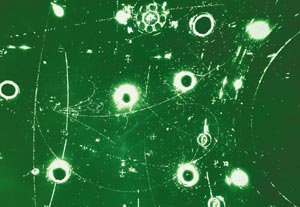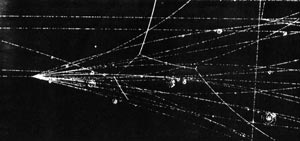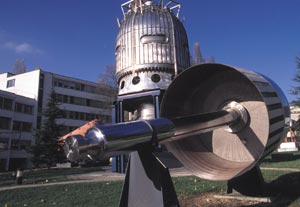Horst Wenninger pieces together many of the aspects that made the bubble-chamber programme an important part of CERN’s development as an international laboratory.

The bubble-chamber programme at CERN began in an atmosphere of enthusiasm soon after the foundation of the organization. The then recently invented bubble chamber was marvellously appropriate for exploiting the new CERN accelerator, the Proton Synchrotron (PS), which could reach energies where new phenomena were expected. The emergence of the electronic computer around the same time also provided a means of dealing with the large numbers of bubble-chamber pictures. New instruments would be built to measure the thousands of metres of film, and so began a period of intense activity at CERN.

The bubble chamber, which was invented in 1952 by Donald Glaser in Michigan, played an important role in experimental physics at particle accelerators. Glaser showed that the trajectories of energetic particles could be made visible by photographing the bubbles that form within a few milliseconds after particles have traversed a suitably superheated liquid. For three decades bubble chambers were to dominate particle physics, especially research on strange particles, until the mid-1980s when developments in electronics and new wire chamber detectors, together with the start of a new era of collider physics, brought an end to the bubble-chamber programmes.
The early bubble chambers were very small, but over the years they increased in size with the largest containing 20 m3 of liquid. More than 100 bubble chambers were built throughout the world, and more than 100 million stereo pictures were taken (“30 years of bubble chamber physics” 2003). More than half of these pictures were taken at CERN by the 30 cm hydrogen bubble chamber, followed by the 81 cm Saclay chamber, the 2 m CERN chamber and finally the Big European Bubble Chamber (BEBC).

In the 1960s bubble chambers became the main tool at CERN for the study of resonances and strange particle physics, keeping hundreds of physicists busy for a decade. The 30 cm hydrogen chamber came into operation at CERN in 1960, followed four years later by the 2 m hydrogen chamber. From the early 1960s CERN also pioneered the use of bubble chambers for the study of neutrino interactions, and it was the great interest in this field that led to the conception and construction of giant bubble chambers such as Gargamelle and BEBC.
In 1966 CERN, France and Germany launched the BEBC project – a giant cryogenic bubble chamber surrounded by a 3.5 T superconducting solenoid magnet that operated at CERN in the West Area neutrino beam line of the Super Proton Synchrotron (SPS) until 1984. Gargamelle, a very large heavy-liquid (freon) chamber constructed at the Ecole Polytechnique in Paris, came to CERN in 1970. It was 2 m in diameter, 4 m long and filled with 10 tonnes of liquid at 20 atmospheres. With a conventional magnet producing a field of almost 2 T, Gargamelle was the tool that in 1973 allowed the discovery of neutral currents.

The contacts between the American laboratories and CERN were very close. The physicists at the time were inspired by the example of the Lawrence Berkeley Laboratory, where bubble-chamber experiments using beams from the Bevatron were available before CERN’s PS started operation. In particular there was close collaboration on the technical side between CERN and the Brookhaven Laboratory. It was during these early years of CERN that the first international collaborations on experiments began, thanks to the distribution of bubble-chamber film and joint analysis efforts. Among the first of the groups measuring film from CERN to start a collaboration were those from Bologna and Pisa, who already had experience analysing film from the 30 cm propane chamber at Brookhaven (Eisler et al. 1957). A group from Warsaw with experience in nuclear emulsions, along with other groups who had worked previously with cloud chambers, also soon joined the collaborations with CERN to analyse bubble-chamber film.

The bubble-chamber exposures in beams at the PS were based on physics proposals, often hotly debated in the experimental committees at CERN. The results obtained by the many collaborations using film from the laboratory contributed to establishing bubble-chamber physics at CERN on the world stage. For example, many of the major verifications of SU3 symmetry – apart from the discovery of the Ω– particle – came from bubble-chamber experiments at CERN during the 1960s and 1970s. The success of SU3 not only illustrated the importance of group theory in contemporary high-energy physics, but also became a vital ingredient of the modern Standard Model of particle physics.

One of the most important highlights of the bubble-chamber era – and an outstanding success story for CERN – was the discovery of weak neutral currents in Gargamelle, the giant heavy-liquid bubble chamber. The chamber was first exposed to the neutrino beam at the PS, where the decisive detection was made. Parallel with the operation of the chamber and the evaluation of the photographs from the PS exposure, detailed background calculations were made on neutron-induced events, which could simulate neutral currents. It turned out that this background was only 15% of the signal and so neutral currents were established. Later, Gargamelle was transferred to the neutrino beam at the SPS and equipped with an external muon identifier.
Beyond physics
The results of the bubble-chamber programme at CERN extended well beyond the intrinsic interest of the physics. Bubble-chamber studies played a major role in the reconstruction of physics in post-war Europe and had a great impact on its further development. Bubble-chamber pictures could be easily transported, and efforts were made to persuade industry to construct measuring instruments that became commercially available. As had happened for nuclear emulsions a few years earlier, many new groups formed in research centres and universities, where young people were trained. These collaborations produced much of the significant physics. At CERN the use of digital computer and data-handling techniques for experiments began with bubble chambers, and their use in other fields of high-energy experimentation followed later.

Bubble-chamber physics became a training ground for physicists, engineers, technicians, and for specialists in computers and data handling. A great number of new techniques were developed to improve particle identification both inside and outside the track-sensitive volume of the bubble chambers. There was the question, for instance, of how best to convert photons resulting from π0 decays inside a hydrogen bubble chamber. This led at CERN to the operation of track-sensitive hydrogen targets, surrounded by neon-hydrogen mixtures, to improve the photon-conversion efficiency.
Over the years there were many other technical developments (Mulholland and Harigel 2003). Proportional wire chambers surrounding the bubble chambers allowed the identification of muon tracks escaping from the inside through the tanks and magnets of the bubble chamber.

Special fish-eye optics, stereo photography and holography were developed to optimize the recording of the particle tracks. Finally, rapid-cycling bubble chambers and hybrid systems, which combined bubble chambers with spectrometers and counters, were constructed. Interaction triggers, in particular for signals of charm events, were used to fire the flash so as to take photographs only of interesting physics events in order to improve on the slow data-taking rate of bubble chambers. CERN’s competence in engineering and cryogenics, which was developed in the Track Chamber Division through the building and exploiting of bubble chambers, later benefited the construction of the detectors for the Large Electron Positron collider and the experiments for the Large Hadron Collider (LHC).

A whole generation of physicists wrote their PhD theses based on bubble-chamber data. Perhaps because of the large numbers of young people who were working in the field of bubble chambers and film analysis, many are to be found today as leaders of experimental teams or laboratories, and indeed in many other diverse areas.
Lastly, and arguably most importantly, bubble-chamber physics initiated on a large scale the symbiosis between CERN and its community of users. Laboratories that at first limited their activities to measuring pictures and analysing the results soon diversified their activities and links with CERN expanded. This became one of the ingredients of CERN’s success. Bubble chambers had initiated the international collaborations for performing experiments that are now extending to the worldwide collaborative efforts for the LHC.

The bubble-chamber era has now ended and the remains of the major CERN bubble chambers are today exhibits in science museums – BEBC and Gargamelle are in the garden outside the Microcosm exhibition at CERN and the 2 m chamber was donated to the Deutsches Museum in Munich. However, bubble chambers live on in other ways, not only through the many beautiful postcards and books showing bubble-chamber tracks, but also through many of the original ideas and the “bubble chamber philosophy” that continues to play an important role in physics today.
Acknowledgments
The author would like to acknowledge some valuable sources of material. Much of this article is based on a memorandum written in 1987 by the late Yves Goldschnidt-Clermont to the CERN history committee (Goldschnidt-Clermont 1987). The proceedings of the “Bubbles 40” conference, held at CERN in 1993 to commemorate the 40th anniversary of the invention of the bubble chamber, document the evolution and impact of bubble chambers on particle physics and physics discoveries and outline their technological, sociological and pedagogical legacies (“Bubbles 40” 1994). Jack Steinberger from CERN recounted his time with bubble chambers in memories of his early life (Steinberger 1997), and the impact of Charles Peyrou on the bubble-chamber programme at CERN is recalled in a tribute published after his death in 2003.
Further reading
“Bubbles 40” 1994 Nuclear Phys. B (Proc. Suppl.) 36.
F Eisler et al. 1957 Phys. Rev. 108 1353.
Y Goldschnidt-Clermont 1987 Memo 10 Nov to CERN history committee “Physics at CERN 1958-1965”.
G T Mulholland and G Harigel 2003 “Liquid Hydrogen: Target, Detector” in AIP Conference Proceedings – Advances in Cryogenic Engineering 710 16.
J Steinberger 1997 Ann. Rev. Nuc. Sci. 47 xiii.
“Thirty years of bubble chamber physics” March 2003, Bologna; see www.bo.infn.it/~spurio/bubble.htm.







